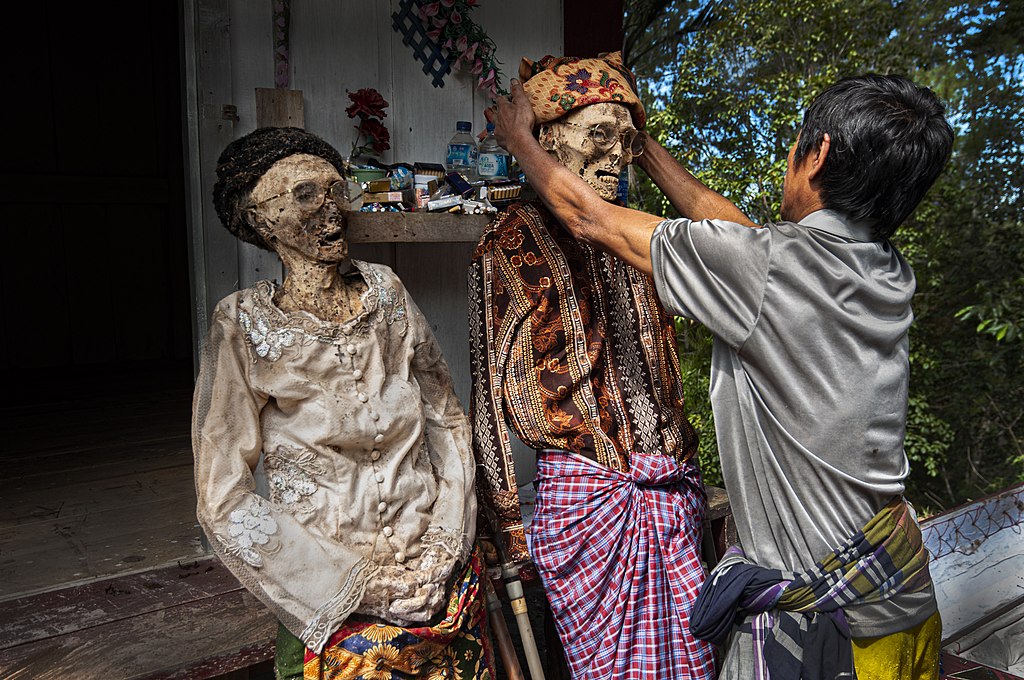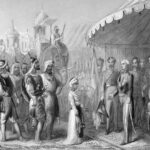Historical Cultures That Kept Their Dead As Household Items
- Jennifer Still
- May 21, 2025
 RaiyaniM, CC BY-SA 4.0
RaiyaniM, CC BY-SA 4.0Throughout history, people have found ways to honour, remember, and even stay close to their dead—sometimes quite literally. In many societies, ancestors weren’t buried and forgotten. They were kept nearby, not only in spirit but in physical form. From skulls on shelves to mummified bodies seated at family dinners, some communities built their homes around the presence of their departed. These practices might sound unsettling to modern sensibilities, but to the people who observed them, they were acts of respect, reverence, and connection.
These are some of the most fascinating historical examples of cultures that kept their dead within reach—not as objects of fear, but as part of everyday life.
The Toraja of Sulawesi, Indonesia
In Torajan culture, death is not an abrupt end but a gradual, extended process. When someone dies, the body is often kept in the family home for weeks, months, or even years until a lavish and proper funeral ceremony—called a Rambu Solo’—can be held. During this time, the deceased is treated as if they are merely ill. Family members speak to them, offer meals, and carry out rituals in their honour.
Even after burial, the dead remain close. Every few years, Torajan families take part in a ritual called Ma’nene, where the deceased are exhumed, cleaned, redressed, and sometimes walked around the village. It’s not seen as macabre—it’s a celebration of continuity, family duty, and social ties that don’t end with death.
The ancient Inca (Andean region)
In the Inca Empire and other Andean societies, death did not separate people from their communities. Ancestors, known as “mallki,” were mummified and often kept in homes or stored in shrines within villages. These mummies weren’t silent observers—they were brought out during major festivals, consulted for decisions, and offered food and chicha (corn beer).
Colonial Spanish sources documented their surprise at seeing mummies dressed in fine clothes, seated upright and treated as honoured guests. The practice reflected the belief that the ancestors still had responsibilities and roles in the community. Their presence reinforced legitimacy, especially among rulers and elders.
The Melanesian cultures of Papua New Guinea
Among the Anga people of Papua New Guinea, smoke mummification was an integral part of how the dead were honoured. Bodies were dried using smoke and fire, then covered in plant resin and displayed in a seated position. These mummies were placed in caves or even mounted on cliff ledges overlooking villages.
Rather than being hidden away, these ancestors became part of the community’s physical and spiritual landscape. They were believed to offer protection and guidance. Some villagers even made pilgrimages to consult them, and their carefully preserved presence helped maintain tribal identity and moral authority.
Neolithic plastered skulls (Levant and Anatolia)
Over 9,000 years ago, early farming communities in the Levant—including what is now Jordan, Syria, Israel, and Turkey—practised a form of ancestor veneration that involved removing and decorating skulls. These skulls were plastered to recreate the features of the deceased, sometimes with painted details and shell-inlaid eyes.
Archaeological finds, such as those from Jericho and Çatalhöyük, suggest that these skulls were kept in homes or community spaces, possibly used in rituals or storytelling. They may have functioned as reminders of family lineage, spiritual protectors, or symbols of continuity. The British Museum houses some of these remarkable relics.
Victorian Britain’s hair jewellery and death portraits
Though more restrained than some ancient traditions, the Victorians found deeply personal ways to keep the dead close. Mourning jewellery—especially lockets, rings, and brooches made using the hair of a deceased loved one—was immensely popular. Hair was seen as enduring and intimate, and these pieces were often worn daily as a symbol of remembrance.
Post-mortem photography was another widespread custom. Families would pose with recently deceased relatives, especially children, sometimes with eyes painted open to simulate life. These photos were often displayed in the home and cherished like family portraits. Far from being taboo, they were an accepted part of mourning and memorialisation.
The Ifugao of the Philippines
The Ifugao people of northern Luzon carved wooden figures called “bulul,” which represented ancestors or rice deities. These figures were not merely symbolic—they were believed to contain the spirits of the dead and to possess active power over agriculture and family welfare.
Bulul were placed in rice granaries, living areas, or altars within the home, and were ritually fed or bathed. The figures were part of the household’s spiritual architecture, a physical connection to those who had passed on but were still deeply present in daily life.
The Dayak of Borneo
Among various Dayak groups in Borneo, the practice of secondary burial involved exhuming bones and placing them in elaborately decorated containers known as “lungun.” These containers were often stored in the communal longhouse, sometimes hanging from the rafters or placed in special rooms.
The dead were not seen as gone—they had simply changed form. Their bones were seen as retaining mana, or spiritual power, and were often involved in rituals or protection rites. Their presence in the home reinforced communal ties and ancestral oversight.
The Etruscans (pre-Roman Italy)
The Etruscans placed strong emphasis on funerary rituals and ancestor worship. Their tombs were designed to resemble houses, complete with furniture, painted murals, and personal effects. The intention was to make the afterlife a continuation of earthly life.
In elite households, it was also common to have funerary urns shaped like miniature humans or to display busts of ancestors prominently. These items served both religious and social functions, reminding the living of their family heritage and reinforcing social status.
The Aymara of Bolivia and Peru
In the highlands of Bolivia and southern Peru, the Aymara people have long practised a form of ancestor veneration that includes keeping human skulls known as “ñatitas.” These skulls, often cleaned and sometimes decorated with hats or flowers, are kept in the home or on altars.
During the Dia de las Ñatitas, families bring the skulls to cemeteries for blessings, believing they offer protection, healing, or advice. While the Catholic Church doesn’t officially sanction the ritual, it remains an important part of spiritual life for many Aymara.
Chinchorro mummies of Chile and Peru
Long before the Egyptians, the Chinchorro people of coastal South America were practising intentional mummification—over 7,000 years ago. These mummies were made using meticulous techniques involving the removal of internal organs, reinforcement of the body with sticks and clay, and the repainting of skin and features.
Evidence suggests that some mummies were kept in homes for extended periods, possibly seated in corners or displayed during ceremonies. This ongoing presence supported the belief that the dead were part of community life—not simply consigned to the afterlife.
For many cultures, the dead were never truly gone.
They remained protectors, advisers, family, and community members. Whether in the form of a lovingly maintained mummy, a decorated skull, or a woven lock of hair, these practices reveal a radically different approach to mortality—one that embraces connection rather than separation.
While modern Western customs tend to hide death away, these traditions suggest an alternative view—one that treats remembrance not as an event, but as an ongoing relationship. In many cases, the dead had a literal seat at the table, a role in decision-making, or a place in daily life. And in doing so, they continued to shape the living world just as much as they had in life.



